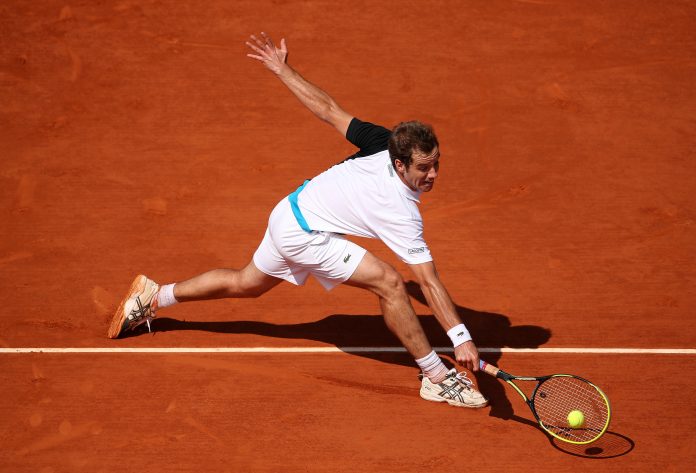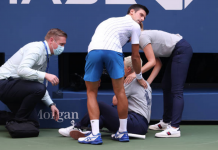BILL SIMONS
French tennis breathes beauty.
French tennis needs beauty.
French tennis exudes beauty.
Creativity is its username – flow its password. With its grace and ease, French tennis paints a unique canvas. Dramatic flair and spontaneous imagination inspire the spirit – slide and blast. Orange courts frame lyrical shots – cosmopolitan crowds cheer, then chant or offer singsong mantras. Neither Monet, Matisse nor Picasso are on court – still, we imagine their strokes.
The French heritage has deep roots. Tennis’ first diva, Suzanne Lenglen, was an on-court ballerina in the 1920s. The leaping lady, who would sip cognac during changeovers, didn’t mind keeping the Queen of England waiting and wore daring frocks that revealed her ankles – OMG.
In the late 1920s, France’s Four Musketeers lifted tennis to the forefront with élan and elegance. They won 43 singles and doubles majors. Our two faves were “Le Crocodile,” René Lacoste, and “The Bounding Basque,” Jean Borotra. Yes, Lacoste’s career was curtailed by injury, but he went on to be central in the emergence of metal rackets, ball machines and the modern tennis shirt.
Borotra was a charismatic character who talked smack and arrived at his matches with five different blue berets, which were actually tactical rally caps, decades before there were rally caps. According to Brit Fred Perry, Borotra “came in to net behind his serve so fast that the ball almost hit him on the back of his head.” Not coincidentally, decades later writer Sue Mott told us that the serve of France’s Francoise Durr “meandered like a concussed bluebottle and sometimes seemed to travel in reverse.”
The Independent reported that Borotra’s matches were like “theatrical productions. On wide shots, he’d leap into the crowd and kiss the hands of any women he had disturbed, charming the flappers who flocked to see him.” Sounds trés French to us – oui?
In the modern era, Borotra had a kindred spirit. Yannick Noah grew up in Africa, where Arthur Ashe discovered him, and then set off to Paris, where, as a young teen, he found romance beneath the stands of Roland Garros. In 1983 he used his refined and accessible athleticism to find glory when he won the French Open. Incredibly, he’s the only Frenchman in 71 years to have prevailed at Roland Garros.
A free-spirited humanist, Noah went on to become a heartthrob rock star who loved to tweak his favorite foil, Ivan Lendl. To him, the great Czech champion was the “the monk-soldier of tennis, obsessed and sad…All that money and he never has the time to smile…I like people who live life with a passion. And in tennis, as in life, everyone should go to the net – take risks. Like the Three Musketeers – attack and live dangerously!”
It’s not exactly shocking that Yannick was the first player to hit a high-profile tweener. More recently, Noah has been France’s inspired Davis and Fed Cup coach. Jo-Willie Tsonga said, “When he sings, I dance. That’s my relationship. When he says something…I listen.”
Over the years, French tennis has had much to say. Henri Leconte‘s wristy shots had a flat flair. Leconte may have seemed to be off in his own spacey domain, but he still blasted his flamethrower strokes with a snappy ferocity. Then, during one Wimbledon semifinal, he paused to delicately remove a small beige butterfly from Centre Court. Somber professionalism was hardly his thing. He recently asked, “Ever woken up at night and walked outside [your hotel room] thinking it was the toilet?…[I] did! Naked, [so I] had to go to the lobby!” In recent years Leconte has evolved into a free-form Charlie Chaplin-like mimic who delights and shocks crowds around the world.
Few have been more appealing than Fabrice Santoro. Armed with clever dinks and unprecedented guile and finesse, for decades “The Magician” sliced and diced his way to wins with his two-handed strokes off of both wings. According to Steve Bierley, Santoro proved that, “Modern tennis need not be all biff and bash.” But Fabrice was not nearly as eccentric as Michael Llodra, who celebrated winning the Aussie Open doubles by stripping down to his jockstrap, and later in Miami clamored naked into Ivan Ljubicic’s locker. When the stunned Croat appeared, Llodra explained, “I’m trying to get positive energy from you. You’re winning a lot of matches.”
Marion Bartoli – a 1,000-1 long shot who came out of nowhere to win Wimbledon – turned around one match when she spotted James Bond (i.e. actor Pierce Brosnan) up in the Royal Box. No other player endured more wacky training techniques. Her dad, an eccentric country doctor who was run out of his provincial French village, put his daughter in a training harness, had her work out in the snow and attached tennis balls to the soles of her shoes to make her stay on her toes. Shadow boxing, air swings and random tics all became part of Bartoli’s jittery on-court routine.
Before the arrival of Nick Kyrgios, France gave us the sport’s most athletic, photogenic and confounding showman – Gael Monfils. lean and angular, he’s as flexible as Djokovic. His leaps are Olympian adventures. One senses he’d rather concoct a beautiful shot than score a big win. Courtney Nguyen wrote, “Infuriating, awe-inspiring, underachieving. These are the words that come to mind whenever I watch Monsieur Monfils. He flies around the court with complete disregard for life and limb, he tries to hit, literally, the dumbest of shots…only to chase down the most ridiculous of balls the next. It’s enough to make the most die-hard of tennis fans swear him off and wonder why we should care when he clearly doesn’t. But we don’t swear off…because we know that in…any given point, we might see something we have never seen before.”
Despite all its creativity, French tennis has issues. At times edgy, and all but paralyzed by nerves, French players can turn Roland Garros into a home field disadvantage. Watching Amelie Mauresmo – who was No. 1 and won Wimbledon and the Australian Open – devolve into mush on the Paris clay became an annual indulgence in schadenfreude. [Editor’s note: apologies for using the German term that means taking pleasure in another’s misfortune in an article on French tennis.]
Plus, France’s players seem to suffer more than their share of injuries. Monfils pulled out of last year’s French Open. Richard Gasquet, who in 2016 beat Nick Kyrgios and Kei Nishikori, is out this year. Once a dazzling prodigy, who was on the cover of France’s tennis magazine at the age of nine, he was touted as a sure-fire champion. For years fans have been chanting, “Wree-shard, Wree-shard!” No wonder Carole Bouchard said Gasquet was “like the baby brother of the country and the people have been babysitting him since he was nine. They love him. And they want him to succeed. At the same time, sometimes he gets on their nerves…It’s a love-hate relationship but more love than hate.” Gasquet gave the game not only one of the most gorgeous backhands ever, but also one of its most inventive alibis. He explained that he tested positive for cocaine because he kissed a woman in Miami. And get this – it worked.
An adept shotmeister, Gasquet cuts off angles like an unhappy butcher. His strokes have more curls then Shirley Temple. He was once ranked No. 7, and he’s scored numerous upsets. Then again, the French have long been upset artists. Lucas Pouille sent Rafa Nadal out of last year’s US Open. And few other recent shock losses were more curious than when Andre Agassi became discombobulated during his 2001 match against Sebastien Grosjean. After the crowd gave the late-arriving President Clinton a rousing ovation, Andre lost twelve of the next fourteen games and a match he should have owned.
And when have we seen a more impactful WTA upset than Virginie Razzano’s devastating win over Serena at the 2012 French Open? The loss – the only one Williams has suffered in the opening round of a Slam – propelled her just days later to seek out Patrick Mouratoglou. Since then the French coaching whiz has led her to victory in 10 of the last 18 Slams she’s played. In contrast, in the 212 Slams Frenchmen have played since 1947, they’ve won only once.
Still, no other nation consistently gives us a more impressive group of top-flight players. In 2006, for the first time in the history of computerized rankings, four players from a single country – Monfils, Tsonga, Gasquet and Gilles Simon – were in the top 20. Since then, the “New Musketeers” have repeated their high-flying feat three times. Thanks to what has been called France’s “quarterfinal cadre,” French is consistently spoken deep into the second week of Slams. Of late, America could only wish for heady men’s results like this But, while Frenchmen have neared the summit (Noah was No. 3, Guy Forget No. 4, Tsonga No. 5, Leconte, Monfils and Simon were all No. 6 and Gasquet was No. 7), none since 1930 has gained the No. 1 ranking.
Rather, France’s prime tennis triumphs have come in team play. The Four Musketeers used the Davis Cup to grab fame. From 1927 to 1932 they won six straight times, an astounding streak that hasn’t been repeated since. While Babe Ruth built Yankee Stadium, the Four Musketeers built Roland Garros Stadium. The French have won two Fed Cup titles and, since 1991, three Davis Cup championships, and have reached four finals. “I think our strength is this strong relationship we have all together,” said Forget.
Still, every spring, French pride takes a hit thanks to the “S” factor. For 26 of the last 42 years, men from “S” countries – Spain, Sweden, Switzerland or Serbia – have sashayed into the City of Lights and left only after having lifted La Coupe des Mousquetaires trophy. And here’s a newsflash: for a decade, the king of French clay has been a snarling Spanish intruder. That would be nine-time champion Señor Nadal – a bruising battler whose modus operandi is forged more in fury than art.
This spring, France had three players in the top 20. But, like the US and Australia, for years they haven’t been able to claim a Slam title. Why? The recent French election stirred heaps of soul-searching. In his vastly popular political book, “France on the Periphery,” Pasquel Bruckner wrote that France is, “A country that doesn’t unleash its potential…so we lapse into mediocrity.” Restaurant owner Cyril Jacauiot told the New York Times that in France there are “too many acquired rights and too little will to work. “
As for tennis, coach Mouratoglou told CNN that France is “a great country to build players. The thing maybe we don’t have — there are exceptions — is the right mentality to raise champions. For the French players things are too easy…They make a lot of money…quite early and I think we lack ambition. Maybe it’s not in the culture of France…Grand Slam winners are people who have very high expectations, who simply have the mentality of champions. I’m not sure too many French players have that mentality.”
Amongst French players one always senses a certain joie de vivre and an appreciation of the tennis life. But is a fierce, do-or-die urgency embedded in their DNA? Guy Forget nonchalantly mused, “If you win, fine. If you don’t, you try again next year.” Monfils told IT, “I create music, I create painting, I create whatever I want to create…I dance and move. I create anything.”
Is French tennis as intriguing as it gets, or what? Not unlike a snooty Parisian waiter putting a hapless tourist in his place, French players can reveal a hint of arrogance. Often in their own lyrical universe, they have a certain camaraderie that can seem insular.
Here infighting thrives. No other tennis nation west of India has more spicy family feuds. Jealousy flares, feelings are bruised. And it’s not just the players. Puffy French officials know well the art of self-congratulation. They named their showcase stadium after an administrator, although clearly Philippe Chatrier was a game-changer. As for the French press corps, they can seem like an erudite mix of Bud Collins and Jean-Paul Sartre. One minute they’ll deconstruct the sacred laws of clay, while the next they’ll ask Richard Gasquet after a devastating loss, “Which pain is worse, the one in your soul, or the one in your body?”
Ultimately, the French Open is a movable feast. No matter how superb the tennis, chatty lunches linger deep into the afternoon. In this Bois de Boulogne world of foie gras and beef filet, cream puffs and dreamy cheeses, food is a sacrament. So the mighty mingle and munch. Certainly one must see and be seen.
Not far from center court is tennis’ hippest gathering ground – the player lounge. A mecca for beautiful people, it’s packed loud with legends and hangers-on, nervous coaches and wide-eyed agents, attentive mothers and lovely ladies with Latin flair. In contrast, the far more innocent kids’ day is a giddy celebration of youth, while the quirky old Bullring Stadium is tennis’ most intimate, fan-friendly venue – a must-see for any tennis lover. And the pomp and circumstance of the final weekend – while not in Wimbledon’s league – puts the game on a pedestal.
All the while, style rules. Debonair people, flawless fashions, liquid strokes – all are beautiful. On court, chess-like battles – probe and retreat – break out with a staccato regularity. Deep mis-directional forehands, slice-and-dice backhands and deceptive dinks weave wondrous webs. Seeing-eye lobs seem destined to fall just inside the baseline and soft-as-a-petal drop shots delicately embrace the textured clay. Here, emotions matter – feelings explode. Players speak their truths. “In tennis,” Monfils explains, “sometimes it’s too stiff – some guys want to keep [their] emotions [inside]. Me, I’m not like this …My culture is to be very fun and to enjoy the life.”
For the spiritual leader of French tennis, Yannick Noah, the purpose of the game is clear. “I just want to be in harmony with life,” he confided. “I want to be successful at tennis, to be good at my work – but to me, the most important thing is to make a whole stadium enjoy themselves. That’s what tennis is to me.”
So French tennis gives us dreamy artists with flowing backhands and a penchant for brainy thoughts and spontaneous delights. After all, beauty has its demands.




















Thanks for sharing this blog. The French language is quite similar to English, so if people know english then they have no hard to learn german.to learn french, it will take some time. You can learn french by reading books or watch french movies, etc.